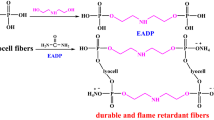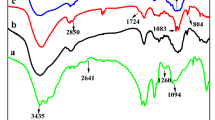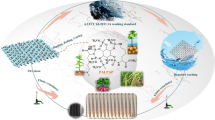Abstract
As a renewable, abundant, and eco-friendly bio-based compound, phytic acid (PA) possesses high phosphorus content, which is a potential flame retardant for cellulosic fibers. Generally, PA is not efficient for cellulosic fibers due to strong acidity that results in greatly reduced strength and lack of soft hand. As proved elsewhere, the compounds with phosphorous and nitrogen was reported to be an efficient flame retardant and exhibited synergistic effect for cellulosic fibers. Therefore, PA was firstly reacted with urea to synthesize a novel green flame retardant containing a high level of phosphorus and nitrogen elements, i.e., phytic acid ammonium, then it was employed for lyocell fibers through pad-dry-cure finishing process. As expected, flame retardancy and durability of finished lyocell fabrics were considerably improved, as evidenced by an increase of limiting oxygen index value up to 39.2% and still 29.7% after 30 laundering cycles. TG–MS and TG–FTIR coupled techniques demonstrate that the formation of carbonaceous residue and non-combustion gases preferably generated during thermal pyrolysis process of finished lyocell fibers.











Similar content being viewed by others
References
Alongi J, Carletto RA, Blasio AD, Carosio F, Bosco F, Malucelli G (2013a) DNA: a novel, green, natural flame retardant and suppressant for cotton. J Mater Chem A 1(15):4779–4785
Alongi J, Carletto RA, Di BA, Cuttica F, Carosio F, Bosco F, Malucelli G (2013b) Intrinsic intumescent-like flame retardant properties of DNA-treated cotton fibers. Carbohydr Polym 96(1):296–304
Alongi J, Carletto RA, Bosco F, Carosio F, Blasio AD, Cuttica F, Antonucci V, Giordano M, Malucelli G (2014) Caseins and hydrophobins as novel green flame retardants for cotton fibers. Polym Degrad Stab 99(1):111–117
Bai BC, Kim EA, Jeon YP, Lee CW, In SJ, Lee YS, Ji SI (2014) Improved flame-retardant properties of lyocell fiber achieved by phosphorus compound. Mater Lett 135(12):226–228
Basak S, Samanta KK, Saxena S, Chattopadhyay SK, Narkar R, Mahangade R, Hadge GB (2015) Flame resistant cellulosic substrate using banana pseudostem sap. Pol J Chem Technol 17(1):123–133
Basak S, Patil PG, Shaikh AJ, Samanta KK (2016) Green coconut shell extract and boric acid: new formulation for making thermally stable cellulosic paper. J Chem Technol Biotechnol 91(11):2871–2881
Bosco F, Carletto RA, Alongi J, Marmo L, Di BA, Malucelli G (2013) Thermal stability and flame resistance of cotton fibers treated with whey proteins. Carbohydr Polym 94(1):372–377
Carosio F, Blasio AD, Alongi J, Malucelli G (2013) Green DNA-based flame retardant coatings assembled through layer by layer. Polymer 54(19):5148–5153
Carosio F, Fontaine G, Alongi J, Bourbigot S (2015) Starch-based layer by layer assembly: efficient and sustainable approach to cotton fire protection. ACS Appl Mater Interfaces 7(22):12158
Cavdar AD (2014) Effect of various wood preservatives on limiting oxygen index levels of fir wood. Measurement 50(1):279–284
Chen X, Jiao C (2008) Thermal degradation characteristics of a novel flame retardant coating using TG-IR technique. Polym Degrad Stab 93(12):2222–2225
Chen L, Wang YZ (2010) A review on flame retardant technology in China. Part I: development of flame retardants. Polym Adv Technol 21(1):1–26
Cheng XW, Guan JP, Tang RC, Liu KQ (2016) Phytic acid as a bio-based phosphorus flame retardant for poly(lactic acid) nonwoven fabric. J Clean Prod 124:114–119
Costes L, Laoutid F, Brohez S, Dubois P (2017) Bio-based flame retardants: when nature meets fire protection. Mater Sci Eng R Rep 117:1–25
Delhom CD, White LA (2010) Development and characterization of cellulose/clay nanocomposites. Compos B 41(6):475–481
Gaan S, Sun G (2007) Effect of phosphorus and nitrogen on flame retardant cellulose: a study of phosphorus compounds. J Anal Appl Pyrolysis 78(2):371–377
Gospodinova N, Grelard A, Jeannin M, Chitanu GC, Carpov A, Thiéry V, Besson T (2002) Efficient solvent-free microwave phosphorylation of microcrystalline cellulose. Green Chem 4(3):220–222
Hadi AH, Zotz G (2014) Phytic acid in green leaves. Plant Biol 16(4):697–701
Hall ME, Horrocks AR, Seddon H (1999) Flammability of lyocell. Polym Degrad Stab 64:505–510
Hendrix JE, Barker RH (2010) Pyrolysis and combustion of cellulose. II. Thermal analysis of mixtures of methyl α-D-glucopyranoside and levoglucosan with model phosphate flame retardants. J Appl Polym Sci 16(1):41–59
Horrocks AR (2011) Flame retardant challenges for textiles and fibres: new chemistry versus innovatory solutions. Polym Degrad Stab 96(3):377–392
Joshi HD, Joshi DH, Patel MG (2010) Dyeing and finishing of lyocell union fibers: an industrial study. Color Technol 126(4):194–200
Kai D, Tan MJ, Pei LC, Yun KC, Yong LY, Xian JL (2016) Towards lignin-based functional materials in a sustainable world. Green Chem 18(5):1175–1200
Kim HG, Bai BC, In SJ, Lee YS (2016) Effects of an inorganic ammonium salt treatment on the flame-retardant performance of lyocell fibers. Carbon Lett 17(1):74–78
Liu H, Wang X, Wu D (2015) Preparation, isothermal kinetics, and performance of a novel epoxy thermosetting system based on phosphazene-cyclomatrix network for halogen-free flame retardancy and high thermal stability. Thermochim Acta 607:60–73
Loubinoux D, Chaunis S (1987) An experimental approach to spinning new cellulose fibers with N-methylmorpholine-oxide as a solvent. Text Res J 57(2):61–65
Mengal N, Syed U, Malik SA, Ali SI, Jeong SH (2016) Citric acid based durable and sustainable flame retardant treatment for lyocell fabric. Carbohydr Polym 153:78–88
Nielsen GD, Wolkoff P (2010) Cancer effects of formaldehyde: a proposal for an indoor air guideline value. Arch Toxicol 84(6):423
Sahito IA, Sun KC, Arbab AA, Qadir MB, Jeong SH (2015) Integrating high electrical conductivity and photocatalytic activity in cotton fabric by cationizing for enriched coating of negatively charged graphene oxide. Carbohydr Polym 130:299–306
Seddon H, Hall M, Horrocks AR (1996) The flame retardancy of lyocell fibres. Polym Degrad Stab 54(2):401–402
Wang X, Lu C, Chen C (2014a) Effect of chicken-feather protein-based flame retardant on flame retarding performance of cotton fabric. J Appl Polym Sci. https://doi.org/10.1002/APP.40584
Wang K, Liu P, Ye Y, Li J, Zhao W, Huang X (2014b) Fabrication of a novel laccase biosensor based on silica nanoparticles modified with phytic acid for sensitive detection of dopamine. Sensors Actuators B Chem 197(197):292–299
Xiong WC, Chen L, Zhao B, Wang DY, Wang YZ (2012) Polyamide 6 with a flame retardant encapsulated by polyamide 66: flame retardation, thermo-decomposition and the potential mechanism. Chin J Polym Sci 30(2):297–307
Xue CH, Zhang L, Wei P, Jia ST (2016) Fabrication of superhydrophobic cotton textiles with flame retardancy. Cellulose 23(2):1471–1480
Yang CQ, Wu W, Xu Y (2005) The combination of a hydroxy-functional organophosphorus oligomer and melamine-formaldehyde as a flame retarding finishing system for cotton. Fire Mater 29(2):109–120
Zhang S, Horrocks AR (2010) Substantive intumescence from phosphorylated 1,3-propanediol derivatives substituted on to cellulose. J Appl Polym Sci 90(12):3165–3172
Zhang T, Yan H, Shen L, Fang Z, Zhang X, Wang J, Zhang B (2014) Chitosan/phytic acid polyelectrolyte complex: a green and renewable intumescent flame retardant system for ethylene–vinyl acetate copolymer. Ind Eng Chem Res 53(49):19199–19207
Zhang QH, Gu J, Chen GQ (2016a) Durable flame retardant finish for silk fabric using boron hybrid silica sol. Appl Surf Sci 387:446–453
Zhang J, Kong Q, Yang L et al (2016b) Few layered Co(OH)2 ultrathin nanosheet-based polyurethane nanocomposites with reduced fire hazard: from eco-friendly flame retardance to sustainable recycling. Green Chem 18(10):3066–3074
Zhao B, Hu Z, Chen L, Liu Y, Wang YZ (2016) A phosphorus—containing inorganic compound as an effective flame retardant for glass—fiber—reinforced polyamide 6. J Appl Polym Sci 119(4):2379–2385
Zhou Y, Ding C, Qian X, An X (2015) Further improvement of flame retardancy of polyaniline-deposited paper composite through using phytic acid as dopant or co-dopant. Carbohydr Polym 115:670–676
Acknowledgments
The authors are very thankful for the support provided by the National Key Research and Development Program of China (No. 2017YFB0309000).
Author information
Authors and Affiliations
Corresponding authors
Rights and permissions
About this article
Cite this article
Liu, Xh., Zhang, Qy., Cheng, Bw. et al. Durable flame retardant cellulosic fibers modified with novel, facile and efficient phytic acid-based finishing agent. Cellulose 25, 799–811 (2018). https://doi.org/10.1007/s10570-017-1550-0
Received:
Accepted:
Published:
Issue Date:
DOI: https://doi.org/10.1007/s10570-017-1550-0




